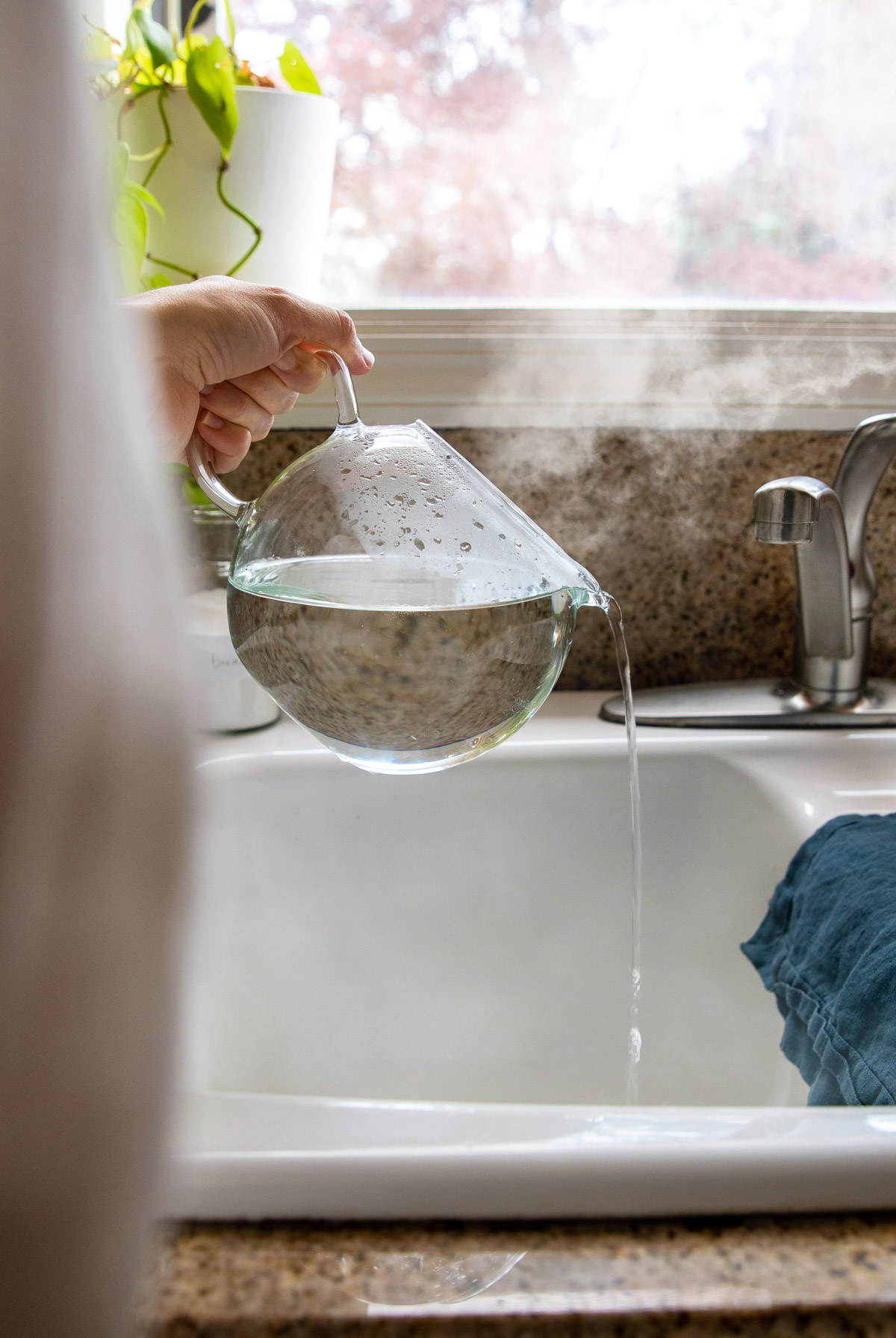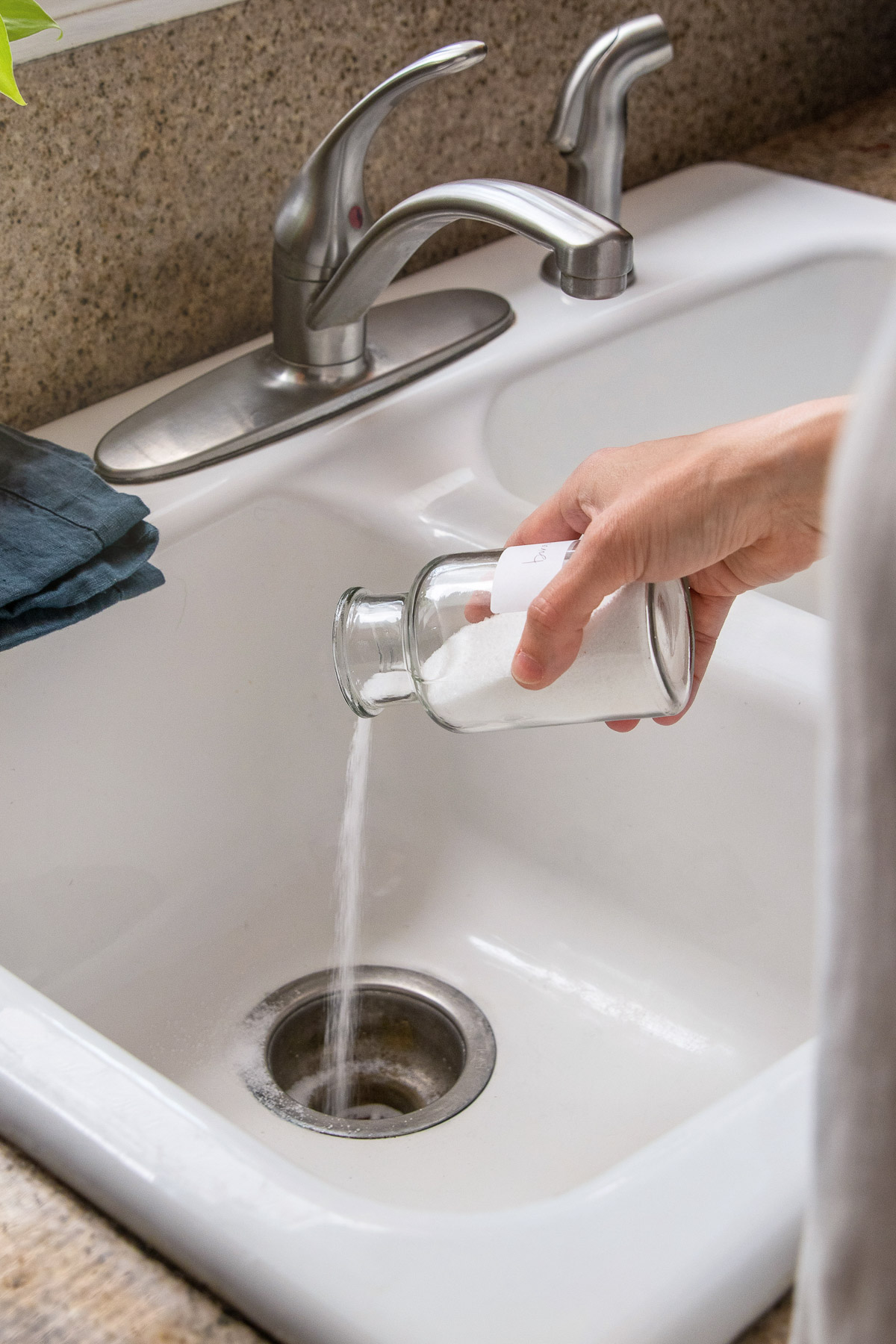Shortly after buying our 1940s bungalow, we learned pretty quickly just how unforgiving old plumbing can be. Especially, if you make your own natural bath and body products regularly, like I do. Since Drano isn’t an option and plumbers charge just for stepping foot in the house, I have come to rely on homemade drain cleaner recipes for getting rid of tough clogs and keeping our drains squeaky clean.
Whether you’re battling a fresh clog or you’d simply like to keep the water flowin’, try giving some of these natural methods a go.
Either start at the top of the list and work your way down, or hop around until you’ve given all the methods a shot. I have used them all of these myself, so I can vouch for their effectiveness, but depending on the severity of the clog, they’re not all suited for every situation. So keep an open mind and experiment!
Homemade Drain Cleaner Recipes
To clean drains and keep clogs from forming in the first place, I recommend keeping your pantry stocked with a few staples. While you probably have most of these things on hand already, if you don’t, it couldn’t hurt to grab extras next time you’re at the store. You know, for emergencies.
Supplies
- Baking soda
- White vinegar
- Table salt
- Dish soap
- Borax
- A clean plunger (for sinks only)
Boiling Water
Before trying all sorts of Drano knockoffs, you might want to see if a simple pot of boiling water can do the trick. If the clog is caused by grease or product build up, the hot water may be enough to melt the oily residue and send the clog on its way.
Bring 6-8 cups of water to a boil in a medium-sized pot. Being careful not to burn yourself, slowly pour the hot water down the drain and let sit. If the water is going down slowly, repeat 1-2 more times and see if that helps. If the water just sits in the sink, it’s likely that more boiling water isn’t going to work, so you may want to move on to something a little stronger.
Lukewarm Water and Dish Soap
A natural drain cleaner made from dish soap and lukewarm water is more effective than you might think. It works by breaking down grease, grime and residue that may be coating pipes while also loosening the clog so it can, hopefully, be flushed down the pipes.
Start by squirting 2 tablespoons of dish soap into a 16-ounce measuring cup and filling the rest of the way with warm water. Give it a stir, then slowly pour it down the drain. Let sit for about 30 minutes before flushing pipes with boiling water.
Baking Soda and Vinegar
Sprinkle approximately ½ cup baking soda down the clogged drain. Next, pour 1 cup of distilled white vinegar down the drain. Lower the stopper to seal the drain and prevent the mixture from bubbling out.
It should foam and bubble for about 15 minutes, and, if all goes as plan, loosen the clog in the process. After 15 minutes, run hot tap water to flush the pipes or follow up with a pot of boiling water.
Alternatively: pour ¼ cup table salt, ¼ cup of Borax and ¼ cup baking soda down the drain for extra clog-busting power. Add ½ cup vinegar and let fizz for 15 minutes before flushing with hot water.
Table Salt
If you don’t have baking soda, another simple way to clean drains is with table salt. Pour roughly ½ cup table salt into the clogged drain followed by 16 ounces of boiling water. Salt is naturally abrasive, which means it can scrub pipes, melt grime, loosen clogs and even deodorize as it sits.
Plunger Method
If all else fails, try clearing pipes with the help of a plunger. Just make sure that it’s a clean plunger reserved for sinks only.
1. Start by removing the sink stopper and placing a wet rag in the sink’s overflow opening to create an airtight seal.
2. Next, place the plunger cup over the drain and run enough water to cover the top of the plunger cup.
3. Move the plunger up and down quickly to loosen and clear the clog.
If none of these homemade drain cleaner recipes work, it’s time to call in the big guns. You can try using a plumbing tool, such as a drain snake, pump or auger, or an enzyme-based drain cleaner that can eat through the clog and get the water moving without damaging pipes.
And if that doesn’t work, well, it’s time to call a plumber.
5


Leave a Reply